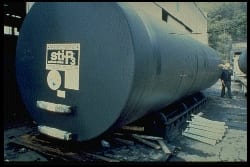Breaking through to realities of cathodic protection
As we’ve described in our previous two articles an introduction to cathodic protection – discussing electrochemical corrosion and how cathodic protection works – cathodic protection is a highly effective method to prevent corrosion. It is used in multiple industries and environments, and without it the cost of corrosion on society, the economy and the environment would be far worse.
In this final article in the series, we dismantle seven common myths about cathodic protection.
Cathodic Protection Myth #1: Cathodic protection protects the whole structure, even if some of it is above the ground.
Reality – There is NO effect at all on the atmospheric corrosion of the piles, columns and beams above ground.
Cathodic Protection Myth #2: Cathodic protection on ONE side of a vessel (pipe/tank/lock gate) can protect both the inside and outside of the structure.
Reality – There is NO effect on corrosion on the other side of the vessel, unless there are holes that allow some cathodic protection current to flow in a common electrolyte from one side to the other.
Cathodic Protection Myth #3: If a buried pipeline is suffering from AC corrosion (AC induced from power transmission lines) it needs more CP to protect it.
Reality – NO! Don’t do it! NO! AC corrosion is complex, and an increased cathodic protection current density and more negative pipe/soil potentials will only enhance the risk of AC corrosion.
Cathodic Protection Myth #4: If I reverse the polarity of my impressed current cathodic protection system, I can pass more current. This must be better.
Reality – This has been done and proved to be incorrect. The structure supposedly being protected becomes the anode, and is consumed at around 10kg per amp per year. Entire sections of pipelines have been destroyed in this way.
Cathodic Protection Myth #5: You can reverse the current with a galvanic anode system.
Reality – In normal situations this is NOT possible. At elevated temperature there can be a reversal between zinc anodes and steel, but only if there are no chlorides present.
Cathodic Protection Myth #6: Galvanic anode CP systems are fit and forget.
Reality – If only this were true! All cathodic protection requires inspection and testing to determine if it is still functional and effective.
Cathodic Protection Myth #7: Galvanic anodes can only deliver a short design life.
Reality – It is normal for offshore structures to be well protected from immersed corrosion for more than 30 years by using aluminium alloy anodes. The early BP Forties platforms in the deep northern North Sea were protected for 40 years with a combination of coatings and large zinc anodes.
The challenges of using cathodic protection
Cathodic protection is used extensively to protect critical infrastructure from corrosion. Common uses include:
- Oil and gas pipelines
- Oil and gas storage facilities
- Offshore oil, gas and renewable energy structures
- Ships
- Reinforced concrete in bridges and other structures
However, cathodic protection is a specialised area, requiring application of corrosion science, electrochemistry, electrical engineering, metallurgy, and, often, structural and mechanical engineering.
The standards (BS EN and BS EN ISOs), that cathodic protection professionals must work to, all make it clear that cathodic protection design must be undertaken by cathodic protection specialists who have a documented and appropriate level of competence.
BS EN ISO 15257 details the competencies that are required in all sectors of cathodic protection (buried, marine, steel-in-concrete, and internal). This standard also details the work that should be undertaken by cathodic protection Data Collectors or Testers, Technicians, Senior Technicians and Specialists or Engineers. Only personnel with appropriate levels of training, experience and competence can undertake work associated with cathodic protection:
- Surveys
- Designs
- Installation
- Testing
- Commissioning
- Performance assessment
- Maintenance
In the UK, certification in accordance with ISO 15257 is increasingly required.
Here’s one final myth that must be exploded:
Bonus Cathodic Protection Myth: There are graduate and postgraduate courses in cathodic protection engineering.
Reality – No, there aren’t! So how do you get the training and certification you need, either for your employees or as an independent cathodic protection specialist?
Breaking the catch 22 in cathodic protection training
It sounds like something of a catch 22, doesn’t it? You must be certified to work with cathodic protection engineering, but there are no specialist courses for graduates or postgraduates. Consequently, specialists may start with a degree in science or engineering – or perhaps an apprenticeship – and then take advantage of specialist training. The Institute of Corrosion offers both courses and certification in cathodic protection.
Our cathodic protection courses are perfect for companies that need their staff trained and certificated in cathodic protection, for independent specialists, and for managers who want a better understanding of what their employees and contractors in cathodic protection should be doing.
These courses provide all the training required (levels 1 to 3) by cathodic protection data collectors, technicians and senior technicians in the sectors of buried, marine, and steel-in-concrete cathodic protection.
In addition, we offer independent assessment of competence as defined in BS EN ISO 15257.
If you are a cathodic protection company or an independent cathodic protection specialist, training and certification from the Institute of Corrosion provides recognition of training, knowledge, skills, experience and expertise that is valid internationally. As the industry continues to become more regulated and standards-led, this recognition will enhance your reputation and work opportunities.
To learn more about our range of cathodic protection training courses and the experience and qualifications needed for certification, please visit our pages detailing the Cathodic Protection, Training, Assessment and Certification Scheme.

